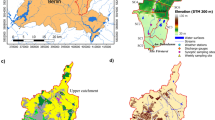Abstract
Highway runoff contains pollutants in concentrations that can harm ecosystems of receiving freshwaters. To suggest control measures the hydrological conditions for pollutant transport from road edge to receiving water, and the associated retention mechanisms must be identified. Often, the transfer of highway runoff to receiving water bodies is accomplished by means of roadside swales equipped with gullies and underdrains. It is well documented that infiltration into the swale constitutes the primary runoff removal mechanism, while surface flow across and along the swale is mainly restricted to heavy storm episodes. Dye tracing at four Danish highways was used to describe the hydrological conditions for leaching of highway runoff pollutants through highway swales. At all sites the surface layer of the exposed swale profiles consists of a homogeneous sandy material deposited after construction of the highway, reaching a thickness correlated with, among other things, the road age. The dye solution infiltrated these deposition layers uniformly, replacing all antecedent soil water. The below-swale soil profiles were percolated through more preferential pathways, but contrary to the expectation no earthworm burrows or other biopores played a part. At two sites the preferential flow patterns resembled macroporous flow through physical voids in heterogeneous construction materials (stony loam) and at borders between construction materials with different texture (gravel, clayey till, fine and coarse sand). At the other two sites, which were built almost exclusively from homogeneous sand, the flow patterns resembled fingered flow initiated around thin, deep-running roots from the surface vegetation. The contaminant transport consequences of these flow patterns are discussed.
Similar content being viewed by others
References
Bouma, J.: 1991, 'Influence of soil macroporosity on environmental quality', Adv. Agron. 46, 1–37.
Characklis, G. W. and Wiesner, M. R.: 1997, 'Particles, metals and water quality in runoff from large urban watershed', J. Environ. Eng. 123, 753–759.
Danish Road Directorate, Trafikrapport 2000, Report 233, Danish Road Directorate, Niels Juels Gade 13, Copenhagen, Denmark (in Danish, Traffic Report 2000)
Edwards, C. A. and Bohlen, P. J.: 1996, Biology and Ecology of Earthworms, Chapmann and Hall, London.
EU: 2000, Directive 2000/60/EC establishing a framework for community action in the field of water policy, OJ L 327, 22.12.2000, P.1.
Flury, M. and Flöhler, H.: 1994, 'Brilliant Blue FCF as a dye tracer for solute transport studies-A toxicological overview', J. Environ. Qual. 23, 1108–1112.
Grout, H., Wiesner, M. R. and Bottero, J.-Y.: 1999, 'Analysis of colloidal phases in urban stormwater runoff', Environ. Sci. Technol. 33, 831–839.
Krarup, J. A., Borch-Jensen, J. E. and Linde-Jensen, J. J.: 1988, 'Vand i veje II. Undersøgelser af vandbevægelse i de ubundne bærelag', Vejdirektoratet. Notat
Lee, P.-K. and Touray, J.-C.: 1998, 'Characteristics of a polluted artificial soil located along a motorway and effects of acidification on the leaching behavior of heavy metals (Pb, Zn, Cd)', Water Res. 32, 3425–3435.
Linde-Jensen, J. J.: 1984, 'Styrede strømningsforsøg på Holbækmotorvejen', in J. E. Borch-Jensen (ed.), Vands bevægelse gennem deøvre jordlag, Seminar 29/5-1984 at Roskilde Højskole, Statens Vejlaboratorium. Notat 172 (In Danish).
Marsalek, J. and Marsalek, P. M.: 1997, 'Characteristics of sediments from a stormwater management pond', Water Sci. Technol. 36, 117–122.
Ritsema, C. J., Dekker, L. W., van den Elsen, E. G. M., Ostindie, K., Steenhuis, T. S., Nieber, J. L.: 1997, 'Recurring fingered flow pathways in a water repellent sandy field soil', Hydrol. Earth Syst. Sci. 4, 777–786.
Stotz, G.: 1987, 'Investigations of the properties of the surface water run-off from federal highways in the FRG', Sci. Total Environ. 59, 329–337.
Thagesen, B.: 1998, 'Veje og stier', Polyteknisk Forlag, Lyngby, Denmark (In Danish).
Author information
Authors and Affiliations
Rights and permissions
About this article
Cite this article
Jensen, M.B. Hydrological Conditions for Contaminant Leaching Through Highway Swales. Water, Air, & Soil Pollution 158, 169–180 (2004). https://doi.org/10.1023/B:WATE.0000044851.30151.e0
Issue Date:
DOI: https://doi.org/10.1023/B:WATE.0000044851.30151.e0




